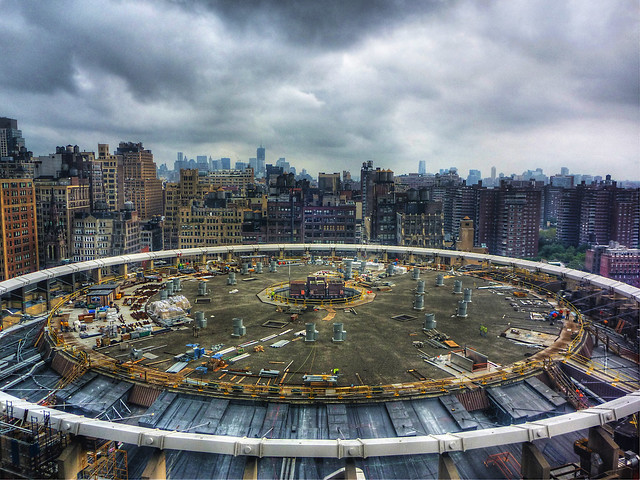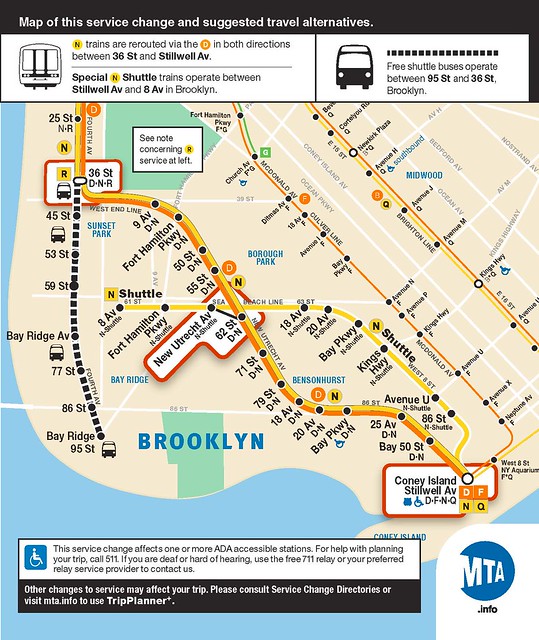
The abandoned 9th Ave. platform, seen here 2002, poses a variety of structural concerns, according to a recent Inspector General report. Photo via NYC Subway.
Over the years, we’ve heard a lot about the two intertwined MTA issues: deferred maintenance and sloppy inspection efforts. The city’s subway network suffered for decades from deferred maintenance, and the agency has struggled to maintain even a state of mediocre repair, let alone a good one. Meanwhile, falsified signal inspection efforts have led to multiple arrests in an ongoing scandal. Now, a new MTA Inspector General’s report sheds light on insufficient structural inspections as well further highlighting the problems with and challenges facing the MTA.
The main gist of the MTA IG report — available here as a PDF — is that the MTA’s efforts at inspecting structural elements of the aboveground portions of the subway is deficient. I’ll get into the details shortly, but the MTA essentially accepted the report and its findings. In a letter to the MTA IG, then-Transit President Tom Prendergast had this to say:
The report and the ongoing discussions with your office during the analysis have been instrumental in helping us look at our overall responsibilities related to structural inspections in a way that will help ensure we not only address any/all deficiencies, but also get the maximum benefit from [our inspections]. We are in agreement with the substance of your findings and all recommendations and are taking a number of actions with respect to the structural inspection process at NYC Transit.
And now some details. From a top-line perspective, the IG found that inspections that should have been conducted annually weren’t happening on time, that no one at Transit was responsible for the Rockaway Viaduct inspections, that inspections of “hard-to-reach station ceilings” were already two years behind schedule, and that abandoned sections of stations that currently provide structural support to active parts haven’t been inspected. If this is now making you fear that your next train is going to tumble off an elevated bridge when the structural supports fail, I don’t completely blame you.
The report goes on to assess each issue on a case-by-case level. For instance, on the elevated sections of the J and Z trains’ BMT Jamaica Line, IG inspectors found $25 million worth of corrosion in various supports. The reports slams Transit’s Maintenance of Way inspectors for missing the damage. “These defects did not pose immediate danger,” the IG said, “but were nevertheless serious and should be corrected as part of a future capital project.”
How the inspectors missed these problems is even more damning. Essentially, they didn’t do a thorough job. The corrosion was evident from the station platforms, and the Inspector General concluded that MOW inspectors “‘had not focused’ on elevated-station-related defects for the past several years…because its inspectors had erroneously believed that Station Maintenance was responsible for conducting these inspections.” This is a classic left hand-right hand problem with potentially serious consequences.
The other explanations follow suit. We know there are issues with vaulted ceilings as we’ve seen them collapse. We know New York City’s bridges are structural deficient because it’s been in the news for years. One aspect of the report, though, struck me as particularly short-sighted, and that area concerns the former 9th Ave. terminal of the Culver Shuttle.
According to the Inspector General, the MTA “does not inspect all structures that are no longer used to provide service to passengers but that still serve as supports for structures above or adjacent to them.” Pick your jaw up off the floor, and I’ll continue. “Most such structures,” the report explains, “are abandoned sections of stations that support structures above, such as active stations, tracks, buildings, or streets.” One is an abandoned station at 9th Ave. on the D train’s West End line.
For decades, the Culver Shuttle’s former terminal has sat unused and above it, is an active station on the D line. Here’s how this tale plays out:
During our review of the West End Rehabilitation, we asked the Chief Engineer about the condition of the lower level of the 9th Avenue Station in Brooklyn, which is part of the West End Line, but has been abandoned since 1975. The lower level supports the upper, active level of the station, including its platforms and tracks. The Chief Engineer told us that personnel from MOW Engineering have been inspecting the lower level on an annual basis. He added that the structure is deteriorated in that it has dozens of “A” defects. He also acknowledged that MOW has known for decades that the structure was in need of repair but had not corrected the conditions. When we asked the Chief Engineer why MOW had allowed the condition to persist for years, he had no explanation. However, he noted that while the structure was in need of immediate repair, in his judgment structural collapse was not imminent because it was “overengineered.” The general superintendent for iron operations26 echoed this view, and also told us that the station was further protected by the five mile-per-hour speed restrictions placed on trains because of the curve in track just south of the station.
After the IG started poking around, the MTA initiated a $20 million repair program to shore up the station supports. When push came to shove, the money materialized.
Ultimately, this moral of this report is one that urges caution and structural soundness, two elements we should expect out of a subway system tasked with moving millions. It also highlights the physical dangers of deferred maintenance. The MTA faces a crushing backlog of good repair projects and simply cannot keep up with demand. Even as Transit vows to improve its inspection efforts, delayed repairs will mount. As the report says, “In our view, NYC Transit simply can no longer tolerate the continued risk presented by critical structure-inspection deficiencies that safety-related structural defects will go undetected and unaddressed.” In other words, better safe than sorry.



















